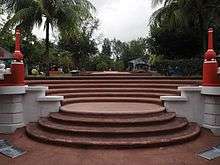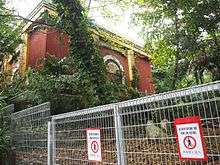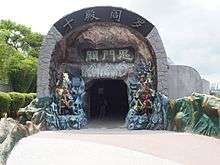Haw Par Villa (Tiger Balm Gardens)
Haw Par Villa (HPV) Haw Par Villa, is a local attraction that used to attract a huge traffic of visitors during its past glory days in the 1980s. But in current times, the number of visitors has dwindled tremendously despite having a Mass Rapid Transit (MRT) station right beside it which is even named after it. The decrease in visits today could be attributed to the high admission cost in 1990s that started the vast decline in visitors for HPV[1]).
The Place and the Owners
HPV, or previously known as Tiger Balms Garden as seen on the first page of this report, was originally owned by the Tycoon Haw Par brothers, Aw Boon Haw and Aw Boon Par where they named the property with both of their names. They gained their fortune mainly through their business of Tiger Balm, a medicated ointment. It was actually a gift from the older brother Aw Boon Haw to his younger brother Aw Boon Par to thank him for his contributions to the family business. The new house had to be one that reflected their wealth and status so Aw Boon Haw chose a site situated on top of the hill along Pasir Panjang road and the architect chosen was Ho Kwong Yew, an architect that is now regarded as an important figure in the Modern Movement in Singapore during the 1930s,[2] The design of the house and the compound was based heavily on the circle motif. From the low walls that guided the roads to the lampposts that support the globe lights, all these represented the significance of family unity between the Aw brothers as circle has such a meaning in Chinese Tradition. The villa which amounted to U.S.$1.95m was completed in 1937 after two years of construction.[3]
During WWII and Post-War Period
Aw Boon Par and his family lived there for less than five years before leaving Singapore in 1941 to flee from the Japanese invasion. After Aw Boon Par’s Death in 1944, the original house was demolished by Aw Boon Haw in 1946 when he returned to Singapore after the war. What is the original structure and what is left of the remnants of the original structure, the stairs.

After the Japanese left, Aw Boon Par returned to Singapore and started rebuilding and modifying tableaux, sculptures and grottoes until 1954 when he passed away (Brandel and Turbeville 1998). His nephew, Aw Cheng Chye, who is also his also the successor to the Tiger Balm business,[4] then continued his work by adding new sculptures to the gardens in the late 1950s. However, after Aw Cheng Chye's death in 1971, the garden had no new additions and remained unchanged. The only alteration was on its surrounding in 1960 where the construction of Hua Kiau Chinese School was completed, situated right beside HPV.
The late 1980s onwards: A New Era
Additionally, as seen on the maps above, you would realize that much has changed regarding the land south of HPV. This is due to the land reclamation work that has been carried out over the last few decades. As a result, the view from HPV then and now are very different. It used to be a picturesque view of the sea instead of the trees and buildings today as seen today. Beyond the trees and buildings lies eight lanes of roads (West Coast highway and Pasir Panjang Road) as well as the shipping port that are not captured in the photo.
Hua Kiau Chinese school was closed officially in 1981.[5] After which HPV was acquired by the government in 1985 through the Land Acquisition Act and subsequently left the management to the Singapore Tourism Promotion Board (STPB)Singapore Tourism Board in 1988. Afterwards, STPB leased it to International Theme Parks Limited (ITP) to develop the place into a theme park and this was when the site of the school was acquired to expand the area of HPV.[6] Constructions took two years and the theme park, known as Haw Par Villa Dragon World reopened in 1990.
The Downfall: Post-closure of the Theme Park
The dragon is no longer there, the amphitheatre and three indoor theatres are also blocked off to public access.

The dragon head was removed when 2004 after ITPL shut down Dragon World in 2001 and handed it back to STPB as they have been incurring a heavy loss while operating the theme park despite charging and admission fee of $16.50 for adults and $10.50 for children from 1990 to 1997, after which they decreased it to $5 for adults and $2.50 for children in view of the poor reception, most of it due to the high admission. After ITPL handed back the management of HPV back to STPB in 2001, many people started questioning whether or not the original free public park should charge an admission and that the admission fee could be the very reason why the park has failed to attract sufficient visitors. During which, STPB then engaged Orient Management to start operating HPV as a free park again. As a result, all the theme park attractions were removed, water was drained and people now walk on foot to view the 10 courts of hell as seen in the picture below. Even the dragon head was subsequently removed in 2004 and has been rebuilt and repainted into a boulder designed tunnel.

In 2006, a new addition, Hua Song museum, dedicated to the Chinese diaspora opened within the park, charging a fee of was $4 for adults and $2.50 for children. However, it proved to be unsustainable in the long run again due to an overall loss in profit hence the operator decided not to renew the contract anymore in 2012. In 2015, the management of HPV switched hands from Orient Management to Journeys pte ltd.
Importance and Significance of HPV
Despite its significance to Singapore and it being the last of its kind of a Chinese theme park that showcases Chinese culture after its sister park in Hong Kong was demolished in 2004, HPV is neither under the conservation list of National Heritage Board's (NHB) Preservation of Sites and Monuments nor conserved by the Urban Redevelopment Authority of Singapore(URA). As seen in the master plan, it is currently zoned under sports and recreation.
After all these renovations work, HPV will be expecting a new visitor centre, a gift shop, five dining outlets, including a food court and a fine-dining restaurant (Lin 2015).
At the same time, to complement the increase in amenities in HPV, the National Heritage Board (NHB) National Heritage Board (Singapore) has also initiated a tender to study the park's sculptures, dioramas and architectural features thoroughly in detail (Zaccheus 2016)[7]
References
- ↑ Rogerson, Marianne (2009). In Singapore. Marshall Cavendish.
- ↑ Woo, Alyssa. ""Stand-Out Tower"". Straits Times. Retrieved 3 March 2017.
- ↑ Turbeville, Brandel; Turbeville, Judith; Turbeville, Tina (1998). Tiger Balm Gardens.
- ↑ King, Sam (1992). Tiger Balm King. Times Books International.
- ↑ Seah, Fiona. "Hua Kiau School". fionaseah.com. Retrieved 3 March 2017.
- ↑ Lim, Irene. "Haw Par Villa (Tiger Balm Gardens)". eresource.nlb.gov.sg. Retrieved 3 March 2017.
- ↑ Zaccheus, Melody (2016). "Heritage Spotlight on Haw Par Villa". Straits Times. Retrieved 3 March 2017.